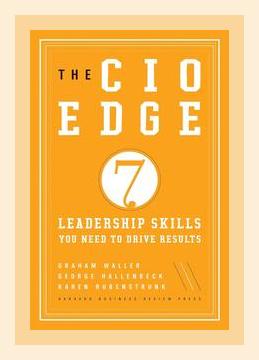Technology and Digital TransformationDigital Strategy
The CIO Edge: Seven Leadership Skills You Need to Drive Results
Authors: Graham Waller, George Hallenbeck, Karen Rubenstrunk
Category: Digital Strategy
Publication Year: 2010
Introduction:
“The CIO Edge: Seven Leadership Skills You Need to Drive Results” is a compelling guide authored by Graham Waller, George Hallenbeck, and Karen Rubenstrunk. This book distills key leadership traits that Chief Information Officers (CIOs) and other digital leaders must cultivate to thrive in the continually evolving technological landscape. It is packed with practical advice supported by vivid examples and actionable steps that can transform a strategic vision into executable results.
1. Commitment to Delivering Value:**
Key Point: The cornerstone for any CIO’s success lies in a relentless commitment to delivering value. The authors emphasize that understanding the business’s core objectives and aligning IT strategies to these goals is essential.
Example: CIOs at top companies work closely with heads of other business units to identify areas where IT can make the most significant impact. One scenario discussed in the book is that of a CIO at a manufacturing company who implemented a data analytics project to streamline the supply chain, resulting in cost savings and faster turnaround times.
Action: Develop a habit of continually asking, “How does this IT project align with business goals?” and measure all IT initiatives against their contribution to company objectives.
2. Creating a Culture of Trust:**
Key Point: Building and maintaining trust within the team and with other executives is crucial. Trust facilitates open communication, collaboration, and ultimately, success.
Example: An example cited involves a CIO who turned around a troubled IT department by fostering a transparent environment where team members felt safe to voice their concerns, contributing to a more cohesive and productive team.
Action: Conduct regular team meetings where transparency is prioritized. Encourage honest feedback and act consistently with your words to build and reinforce trust.
3. Influence Beyond Formal Authority:**
Key Point: CIOs must learn to wield influence beyond their formal authority. Influence encompasses the ability to persuade, advocate for ideas, and drive consensus across different departments and organizational levels.
Example: The book details a CIO who played a critical role in a company-wide ERP system implementation by leveraging relationships and her personal credibility to gain buy-in from skeptical stakeholders.
Action: Engage in active listening and build relationships across the organization. Develop the ability to tailor your message to different audiences to ensure your ideas resonate organizationally.
4. Focus on Business Outcomes:**
Key Point: It’s essential to keep focusing on business outcomes rather than just technology outputs. The role of a CIO goes beyond managing IT infrastructure; it’s about ensuring that IT initiatives bring real business benefits.
Example: The authors discuss a CIO at a retail chain who prioritized initiatives to improve the customer experience by integrating AI-driven customer service systems that reduced response times and increased customer satisfaction.
Action: When launching a new IT project, identify the business metrics that the project will influence. Track these metrics to assess the project’s impact on business outcomes continuously.
5. World-Class Communication Skills:**
Key Point: The ability to communicate effectively with both technical and non-technical stakeholders is paramount. Great CIOs can articulate complex IT concepts in a way that is understandable and engaging for the broader business.
Example: A featured story includes a CIO who successfully navigated a cloud migration project by consistently conducting workshops, using whiteboard sessions, and simplifying technical jargon to ensure that everyone involved understood the project’s scope and benefits.
Action: Invest in communication training programs and practice translating technical jargon into business language. Regularly seek feedback on your communication style and make adjustments as necessary.
6. Empathy and Emotional Intelligence:**
Key Point: Emotional intelligence, especially empathy, is vital in leadership. Understanding and managing your own emotions, and those of others, can enhance team performance and morale.
Example: In the book, a CIO who navigated a major infrastructure overhaul did so with a high degree of empathy, ensuring that the transition was as smooth as possible for all employees, thus minimizing resistance and anxiety.
Action: Practice active listening and show genuine concern for your team’s well-being. Conduct one-on-one meetings to understand their challenges and offer support where needed.
7. Relentless Pursuit of Innovation:**
Key Point: In a rapidly changing technological landscape, CIOs must be at the forefront of innovation. This doesn’t just mean adopting the latest tech but also fostering a culture that encourages creative problem-solving and new ideas.
Example: The authors highlight a case where a CIO introduced hackathons and innovation labs within the organization, leading to incremental and breakthrough innovations that gave the company a competitive edge.
Action: Encourage a culture of experimentation within your team. Allocate time for brainstorming sessions, pilot projects, and regularly review emerging technologies to identify potential applications within your organization.
Conclusion:
The authors of “The CIO Edge” underscore that while technical skills are critical, the differentiating factors for a successful CIO lie in leadership abilities and strategic alignment with business goals. This book presents a well-rounded approach to developing these skills, with actionable advice drawn from a wealth of real-world examples. Each chapter not only identifies a key leadership trait but also provides practical steps for developing that trait, making it a must-read for any aspiring or current CIO. By following the guidance in this book, digital leaders can effectively drive their organizations toward achieving significant and sustained results.
